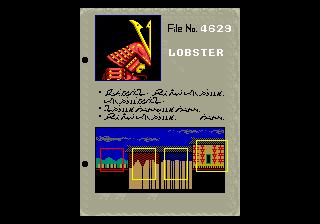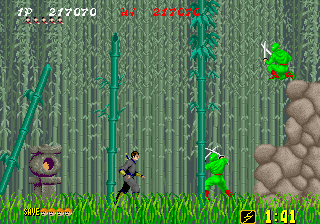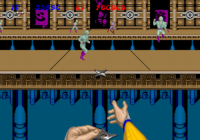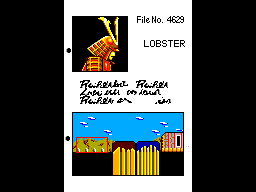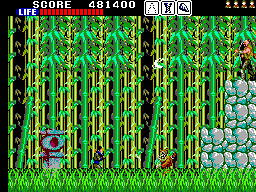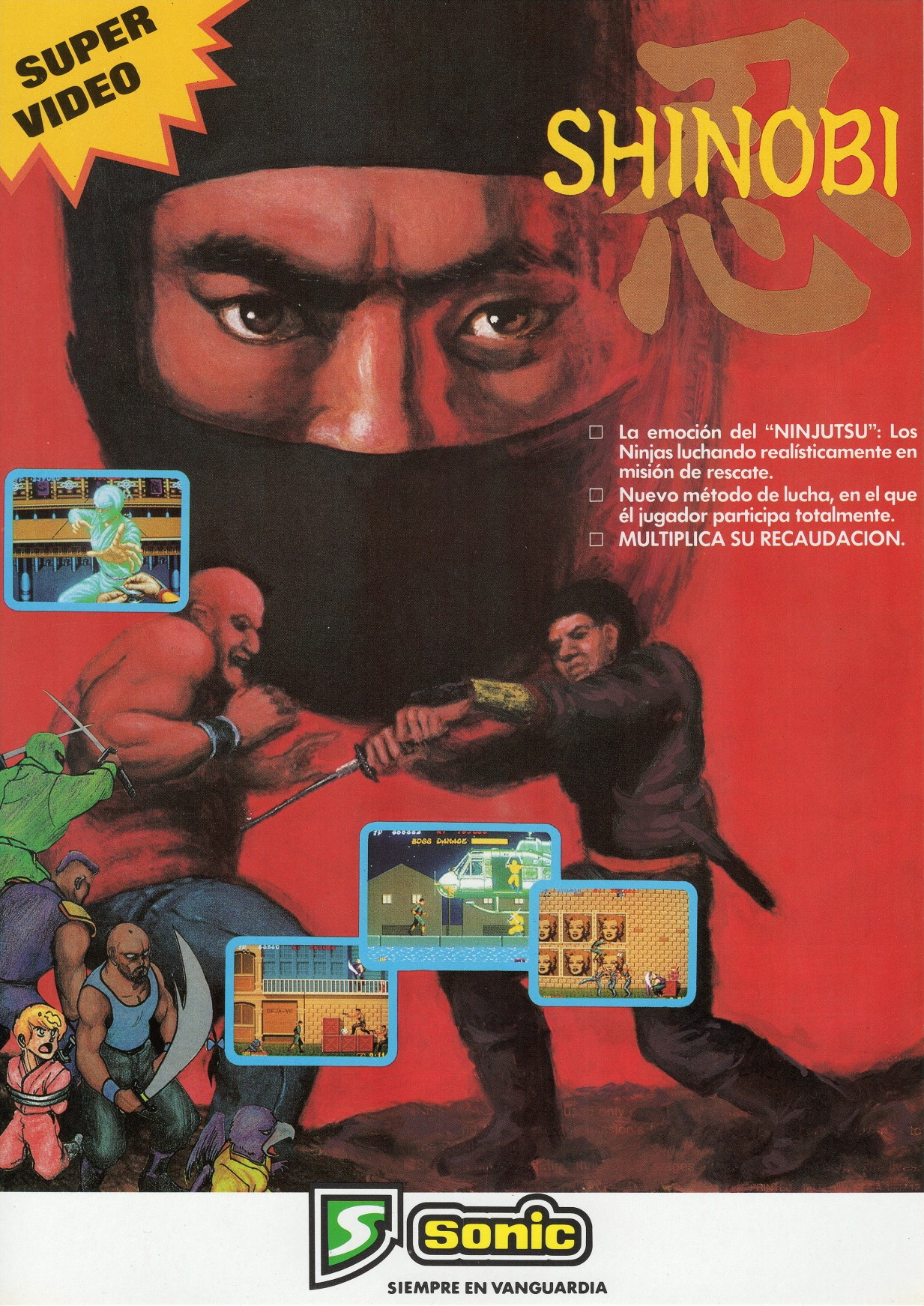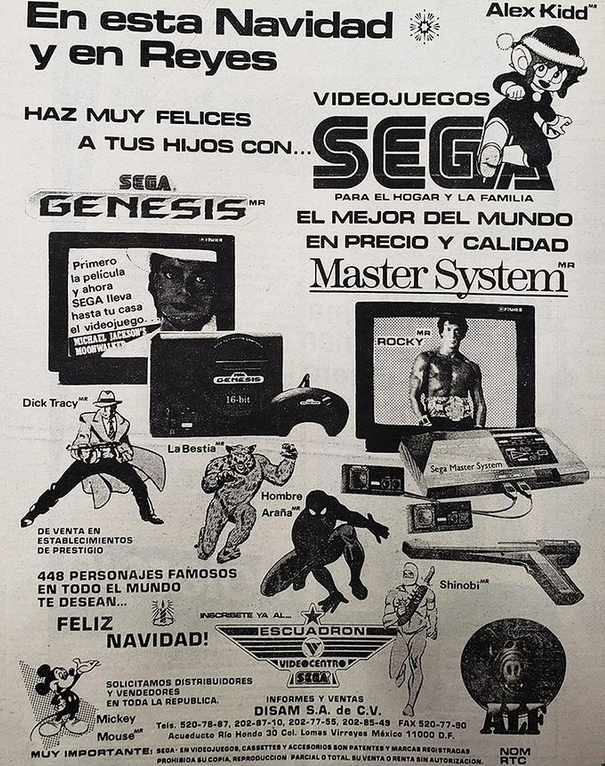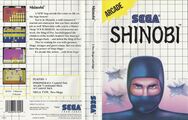Difference between revisions of "Shinobi"
From Sega Retro
MarioSnicU (talk | contribs) |
|||
| Line 19: | Line 19: | ||
| distributor={{company|[[Segasa|Sonic]]|system=SYS16|region=ES}} | | distributor={{company|[[Segasa|Sonic]]|system=SYS16|region=ES}} | ||
{{company|[[Tonka]]|system=SMS|region=US}} | {{company|[[Tonka]]|system=SMS|region=US}} | ||
| + | {{company|[[Tec Toy]]|system=SMS|region=BR}} | ||
| licensor={{company|[[Sega]]|system=NES,PCE}} | | licensor={{company|[[Sega]]|system=NES,PCE}} | ||
| system=[[Sega System 16]], [[Sega Master System]], [[NES]], [[PC Engine]], [[Virtual Console]], [[Xbox 360]] | | system=[[Sega System 16]], [[Sega Master System]], [[NES]], [[PC Engine]], [[Virtual Console]], [[Xbox 360]] | ||
Revision as of 04:23, 23 August 2024
- For the home computer versions, see Shinobi (home computers). For the PlayStation 2 game, see Shinobi (2002).
| ||||||||||||||||||||||||||||||||||||||||||||||||||||||||||||||||||||||||||||||||||||||||||||||||||||||||||||||||||||||||||||||||||||||||||||||||||||||||||||||||||||
| Shinobi | ||||||||||||||||||||||||||||||||||||||||||||||||||||||||||||||||||||||||||||||||||||||||||||||||||||||||||||||||||||||||||||||||||||||||||||||||||||||||||||||||||||
|---|---|---|---|---|---|---|---|---|---|---|---|---|---|---|---|---|---|---|---|---|---|---|---|---|---|---|---|---|---|---|---|---|---|---|---|---|---|---|---|---|---|---|---|---|---|---|---|---|---|---|---|---|---|---|---|---|---|---|---|---|---|---|---|---|---|---|---|---|---|---|---|---|---|---|---|---|---|---|---|---|---|---|---|---|---|---|---|---|---|---|---|---|---|---|---|---|---|---|---|---|---|---|---|---|---|---|---|---|---|---|---|---|---|---|---|---|---|---|---|---|---|---|---|---|---|---|---|---|---|---|---|---|---|---|---|---|---|---|---|---|---|---|---|---|---|---|---|---|---|---|---|---|---|---|---|---|---|---|---|---|---|---|---|---|
| System(s): Sega System 16, Sega Master System, NES, PC Engine, Virtual Console, Xbox 360 | ||||||||||||||||||||||||||||||||||||||||||||||||||||||||||||||||||||||||||||||||||||||||||||||||||||||||||||||||||||||||||||||||||||||||||||||||||||||||||||||||||||
| Publisher: Sega Tengen Asmik | ||||||||||||||||||||||||||||||||||||||||||||||||||||||||||||||||||||||||||||||||||||||||||||||||||||||||||||||||||||||||||||||||||||||||||||||||||||||||||||||||||||
| Developer: Sega R&D 1 Sega R&D 2 Sanritsu Asmik M2[1] | ||||||||||||||||||||||||||||||||||||||||||||||||||||||||||||||||||||||||||||||||||||||||||||||||||||||||||||||||||||||||||||||||||||||||||||||||||||||||||||||||||||
| Distributor: Sonic (ES) Tonka (US) Tec Toy (BR) | ||||||||||||||||||||||||||||||||||||||||||||||||||||||||||||||||||||||||||||||||||||||||||||||||||||||||||||||||||||||||||||||||||||||||||||||||||||||||||||||||||||
| Licensor: Sega | ||||||||||||||||||||||||||||||||||||||||||||||||||||||||||||||||||||||||||||||||||||||||||||||||||||||||||||||||||||||||||||||||||||||||||||||||||||||||||||||||||||
| Peripherals supported: FM Sound Unit | ||||||||||||||||||||||||||||||||||||||||||||||||||||||||||||||||||||||||||||||||||||||||||||||||||||||||||||||||||||||||||||||||||||||||||||||||||||||||||||||||||||
| Genre: Action[2], Arcade[3] | ||||||||||||||||||||||||||||||||||||||||||||||||||||||||||||||||||||||||||||||||||||||||||||||||||||||||||||||||||||||||||||||||||||||||||||||||||||||||||||||||||||
| Number of players: 1 | ||||||||||||||||||||||||||||||||||||||||||||||||||||||||||||||||||||||||||||||||||||||||||||||||||||||||||||||||||||||||||||||||||||||||||||||||||||||||||||||||||||
|
Shinobi (忍) is a Sega System 16 arcade game developed by Sega. It follows the journey of a ninja called Joe Musashi who must free children from his clan from the evil Zeed organisation.
Contents
Story
| “ | 赤忍者、青忍者、黄忍者、そしてアウトローたちが集合した極悪非道のシンジケートに、子供忍者が囚われてしまった。体術、忍術の奥義を極めた“ジョー・ムサシ”は、救出とシンジケート壊滅のため単身敵地へと向かう。ムサシよ、正義の忍術で悪を断て。 | „ |
| “ | A dangerous group of evil criminals has taken people and are holding them as hostages. Musashi, a master of Ninjutsu and other martial arts, fights single handedly in the opponent's territory on a mission to rescue the hostages and wipe out the band of villains. | „ |
A ninja named Joe Musashi must stop a criminal organization called Zeed from kidnapping the children of his ninja clan.
Gameplay
System 16 version
The game is a side-scrolling action platformer that resembles Namco's earlier arcade hit Rolling Thunder. The player controls the ninja Joe Musashi, who is on a mission to stop the Zeed terrorist organization, which has been kidnapping students of his clan. Musashi must rescue all of the hostage children in each stage (by finding and touching them), then find the exit. Because Musashi can only sustain one hit before dying, the player is encouraged to move through each stage and clear enemies deliberately and methodically. The controls consist of an eight-way joystick and three action buttons for attacking, jumping, and using ninjutsu techniques called "ninja magic."
Musashi walks with ![]() or
or ![]() . He can crouch with
. He can crouch with ![]() or perform a crouching walk with
or perform a crouching walk with ![]() or
or ![]() , which allows him to sneak under enemy projectiles. Stages are designed to have multiple floors, and Musashi can jump between floors by holding
, which allows him to sneak under enemy projectiles. Stages are designed to have multiple floors, and Musashi can jump between floors by holding ![]() or
or ![]() while pressing the jump button. He cannot attack enemies on different floors or be attacked by them. Musashi fights with punches and kicks when enemies are nearby and by throwing shurikens (which are unlimited in supply) otherwise. Rescuing certain hostages in each stage upgrades Musashi's weapons by replacing his throwing stars with a gun and his close-ranged attacks with a katana slash. He can use his ninja magic once on every stage, which attacks every enemy on screen at once.
while pressing the jump button. He cannot attack enemies on different floors or be attacked by them. Musashi fights with punches and kicks when enemies are nearby and by throwing shurikens (which are unlimited in supply) otherwise. Rescuing certain hostages in each stage upgrades Musashi's weapons by replacing his throwing stars with a gun and his close-ranged attacks with a katana slash. He can use his ninja magic once on every stage, which attacks every enemy on screen at once.
Hostages are guarded by enemies that include mohawked punks, mercenary thugs wielding knives or guns, other ninjas, and Mongolian swordsmen. If Musashi touches most enemies, he is bumped back without being harmed (with ninjas being a notable exception because of their katanas). However, he is killed in one hit if he is struck by an enemy's weapon (including projectile attacks) or killed instantly if he falls into a bottomless pit. When the player runs out of lives, additional coins continue the game except the final mission. The time limit is three minutes per stage and bonus points are awarded for time, with additional bonuses for refraining from ninjutsu technique (except on the final round) or using only melee attacks. Extra lives are awarded for achieving certain scores, completing the bonus round, or rescuing a special hostage.
Ninjutsu spells
Ninjutsu techniques can only be used once per stage and clear the screen of all enemies or greatly damage a boss. A different technique is chosen for the player on each stage.
| Doppelgängers | |
|---|---|
| Summons duplicates of Musashi to attack all enemies on screen. | |
| Thunderstorm | |
| Summons bolts of lightning to destroy all enemies on screen. | |
| Tornado | |
| Summons whirlwinds to destroy all enemies on screen. |
Items
| Child | |
|---|---|
| Musashi must rescue all of the hostage children in a stage before finding the exit. | |
| Bonus Points | |
| Most rescued children give 200, 500, or 1,000 bonus points when collected. | |
| Pow | |
| Some rescued children give a Pow bonus, which upgrades Musashi's shurikens to a gun and his melee attacks to a sword. |
Missions
The first mission has three stages, but all the subsequent missions have four stages. The last stage of each mission is a boss encounter.
| Slums | |
|---|---|
|
Boss: Ken Oh | |
| Musashi fights through the slums of a major metropolis, encountering knife-wielding punks and armed thugs. Ken-Oh, a three-meter-tall behemoth of a man who attacks with guided fireballs, awaits at the end. | |
| Harbor | |
|
Boss: Black Turtle | |
| Musashi makes his way through the shipyards and enters an ominous-looking freighter with blood red walls. Frogmen try to hinder his progress as he passes through the pier. At the end of the stage, he faces the Black Turtle, a heavily armed transport helicopter that swarms him with its full complement of flying ninjas. | |
| Weapons Factory | |
|
Boss: Mandara | |
| Deep within the mountain range, Musashi infiltrates the factory that supplies the armies of the Ring of Five with state of the art weapons. He must eliminate brutes armed with rocket launchers and vicious green ninjas. Musashi must battle Mandara at the end. It is possible to time the jumps to hit two statues at a time. The electric bolt at the back of the room can kill Musashi in a single touch if he is not careful. | |
| Outpost | |
|
Boss: Lobster | |
| Musashi traverses another mountain range with numerous pitfalls and enemies at the every corner. Musashi must defeat Lobster, a gigantic, heavily armored samurai warrior who can only be hurt when he lowers his sword from his face. | |
| Enemy Base | |
|
Boss: Masked Ninja | |
| Victory is at hand if Musashi can survive the endless waves of enemies. He must move slowly through the bamboo forest to avoid being swarmed by ninjas who swoop down on him like meteors. Inside the Masked Ninja's castle, Musashi faces aggressive and relentless monks who chase him down with their staves. At the end of the stage, the Masked Ninja is ready to fight Musashi to death.
In his first form, he jumps around while protected by a magic shield. His shield disappears momentarily when he lands, which is when he is vulnerable to attack. In his second from, he turns into a tornado and attacks with wind slashes. In his third form, he makes series of long jumps and can be attacked when he lands. In his final form, he runs towards Musashi at full speed and attacks. |
Bonus stage
A bonus stage is played after defeating the boss of each mission. It has a first-person perspective where Musashi he tosses shuriken at incoming enemy ninjas. The player is awarded an extra life for successfully completing the bonus round, but it is failed if a ninja makes it past the shurikens and attacks the player.
Master System version
Shinobi is a side-scrolling action platforming game played as the ninja master Joe Musashi. Rescuing children is optional in this version, but doing so provides bonuses such as upgrades to the close and long-range weapons, restoring or expanding the health gauge, or accessing the bonus stage.
Musashi walks with ![]() and
and ![]() and crouches with
and crouches with ![]() . He can move while crouching with
. He can move while crouching with ![]() and
and ![]() . Musashi attacks with
. Musashi attacks with ![]() . Initially, he throws shurikens from a distance or punches or kicks (when crouching) enemies in close quarters. He jumps with
. Initially, he throws shurikens from a distance or punches or kicks (when crouching) enemies in close quarters. He jumps with ![]() . Stages are designed with multiple vertical levels, and Musashi can jump between them with
. Stages are designed with multiple vertical levels, and Musashi can jump between them with ![]() +
+![]() and
and ![]() +
+![]() . Musashi cannot interact with a level unless he is standing on it (including attacking or being attacked by enemies or rescuing hostages).
. Musashi cannot interact with a level unless he is standing on it (including attacking or being attacked by enemies or rescuing hostages).
Instead of one-hit kills, Musashi now has a health gauge before losing a life. He can extend the length of his health gauge by collecting bonuses given by some hostages. Musashi can bump into most enemies without harm and is only harmed if he is struck by an enemy's attack or a projectile. The stage restarts if Musashi takes damage without any health remaining or falls down a bottomless pit, which costs a life and any weapon or life bonuses. The game ends if the player runs out of lives. The player receives an extra life for every 100,000 points earned.
Power-ups
These bonuses are awarded for rescuing children. A message appears in the top-right corner of the screen when a hostage is rescued to indicate which bonus or which weapon was received.
- Power Up: Upgrades Musashi's projectile attack.
- Sword, Nunchaku, or Chain: Changes Musashi's melee attack.
- Life Max: Fully recovers Musashi's health.
- Life Up: Increases Musashi's health limit.
- Bonus Stage: Enters the bonus stage after completing the current stage.
- 10,000 Pts: Awards 10,000 bonus points.
Weapons
Projectile
Musashi throws projectile weapons when there are no enemies adjacent to him.
- Shuriken: The starting ranged attack. Travels the full length of the screen. Only one can be on screen at a time.
- Shuriken Tempo Up: Allows Musashi to throw a second shuriken without waiting for the first to disappear.
- Throwing Knives: Move faster than shurikens.
- Hand Grenades: Powerful but short-ranged. Roll along the ground if thrown while crouching.
- Handgun: The most powerful weapon. It can kill any regular enemy with a single shot.
Melee
Musashi uses melee attacks when there is an enemy in close range.
- Punches and Kicks: The starting melee attacks. Punches are performed while standing, and kicks are performed while crouching.
- Sword: The sword does the same damage as punches and kicks but attacks more quickly.
- Nunchaku: Two sticks linked by a short chain. They do more damage and have longer reach than the sword.
- Manriki-Kusari: A length of chain with a weight attached at the end. It does the most damage and has the longest reach.
Ninjutsu spells
Musashi can acquire special ninjutsu abilities from the bonus stages. Each use of a ninjutsu ability appears in the status area as an icon. The player can hold as many as four ninjutsu abilities at a time. After eliminating 10 enemies in a stage, the leftmost icon begins to blink, which indicates that a ninjutsu ability can now be used. The player can unleash Musashi's ninja magic by holding ![]() until Musashi poses and then pressing
until Musashi poses and then pressing ![]() . Defeating another 10 enemies allows Musashi to use another ninja spell. Ninja magic cannot be used in the boss battles or bonus stages.
. Defeating another 10 enemies allows Musashi to use another ninja spell. Ninja magic cannot be used in the boss battles or bonus stages.
| Metal Binding (金縛りの術) | |
|---|---|
| Paralyzes all enemies on the screen. | |
| Flying Squirrel (ムササビの術) | |
| Allows Musashi to fly for a duration. He moves in any direction using the D-Pad. | |
| Eight Hands (分身の術) | |
| Creates eight other selves that kill all enemies on the screen. | |
| Lightning (稲妻の術) | |
| Calls down lightning to kill all enemies on the screen. | |
| Tornado (龍巻の術) | |
| Summons a whirlwind to kill all enemies on the screen. | |
| Invincibility (園雲隠れの術) | |
| Renders Musashi immune to enemy attacks for the rest of the stage. He can still die if he falls down a bottomless pit. |
Missions
The first mission has three stages, but all the subsequent missions have four stages. The last stage of each mission is a boss encounter.
| Slums | |
|---|---|
| Maps: 1️⃣ | 2️⃣
Boss: Ken Oh | |
| Harbor | |
| Maps: 1️⃣ | 2️⃣ | 3️⃣
Boss: Black Turtle | |
| Weapons Factory | |
| Maps: 1️⃣ | 2️⃣ | 3️⃣
Boss: Mandara | |
| Outpost | |
| Maps: 1️⃣ | 2️⃣ | 3️⃣
Boss: Lobster | |
| Enemy Base | |
| Maps: 1️⃣ | 2️⃣ | 3️⃣
Boss: Masked Ninja | |
Bonus stage
Some hostages, when rescued, provide access to the bonus stage. The bonus stage plays like a shooting gallery game, with Musashi throwing shurikens from a first-person perspective at ninjas as they run across two platforms. The player aims with ![]() and
and ![]() and throws a shuriken with
and throws a shuriken with ![]() or
or ![]() .
.
The ninjas start on the furthest platform and make their way to the closest platform. The bonus stage is failed if a ninja slips through and attacks Musashi. Otherwise, the player earns 500 points for each ninja successfully killed and Musashi gains the use of a ninjutsu ability. Most of the ninjas that appear are green, but one blue ninja appears and runs more quickly than the others. Killing this ninja awards a second use of the same ninjutsu ability if the round is completed successfully.
Achievements
- Main article: Shinobi/Achievements.
History
Legacy
As well as being released in arcades, the game was brought to the Sega Master System in 1988. It was also brought to the Amiga, Amstrad CPC, Atari ST, Commodore 64, DOS computers, MSX, NES, PC Engine, and ZX Spectrum.
More recently, the arcade version has been released on the Xbox Live Arcade and Virtual Console services for the Xbox 360 and Wii consoles respectively. These versions change the posters of Marilyn Monroe to the werewolf from Altered Beast and recolor the Spider-Man-like enemies.
A number of sequels followed, the first two being developed together and released in 1989: Shadow Dancer for the arcade, and The Revenge of Shinobi for the Sega Mega Drive (and later the Mega-Tech).
Production credits
- Main article: Shinobi/Production credits.
Magazine articles
- Main article: Shinobi/Magazine articles.
Promotional material
Physical scans
System 16 version
| Sega Retro Average | ||||||||||||||
|---|---|---|---|---|---|---|---|---|---|---|---|---|---|---|
|
| 80 | |
|---|---|
| Based on 2 reviews | |
Master System version
| Sega Retro Average | |||||||||||||||||||||||||||||||||||||||||||||||||||||||||||||||||||||||||||||||||||||||||||||||||||
|---|---|---|---|---|---|---|---|---|---|---|---|---|---|---|---|---|---|---|---|---|---|---|---|---|---|---|---|---|---|---|---|---|---|---|---|---|---|---|---|---|---|---|---|---|---|---|---|---|---|---|---|---|---|---|---|---|---|---|---|---|---|---|---|---|---|---|---|---|---|---|---|---|---|---|---|---|---|---|---|---|---|---|---|---|---|---|---|---|---|---|---|---|---|---|---|---|---|---|---|
|
| 82 | |
|---|---|
| Based on 19 reviews | |
| Master System, SE (Brio) |
|---|
|
| Master System, SE (Dennis Bergström) |
|---|
|
| Master System, BX† |
|---|
NES version
| NES, US |
|---|
PC Engine version
| Sega Retro Average | ||||||||||||||||||||||||||||||||||||||||||||
|---|---|---|---|---|---|---|---|---|---|---|---|---|---|---|---|---|---|---|---|---|---|---|---|---|---|---|---|---|---|---|---|---|---|---|---|---|---|---|---|---|---|---|---|---|
|
| 81 | |
|---|---|
| Based on 8 reviews | |
| PC Engine, JP |
|---|
Mega-Tech version
Technical information
ROM dump status
| System | Hash | Size | Build Date | Source | Comments | |||||||||
|---|---|---|---|---|---|---|---|---|---|---|---|---|---|---|
| ✔ |
|
256kB | Cartridge (US/EU/BR) | Rev 1 | ||||||||||
| ✔ |
|
256kB | Cartridge (JP/BR) | |||||||||||
| ✔ |
|
256kB | Cartridge (US) | |||||||||||
| ✔ |
|
384kB | Card (JP) |
External links
- Sega of Japan Virtual Console pages: Arcade
- Nintendo catalogue pages: US, AU
- Shinobi on Xbox Marketplace: JP, US, UK, AU
References
NEC Retro has more information related to Shinobi
|
- ↑ https://www.mtwo.co.jp/development/retrogame-2/#tab-3
- ↑ 2.0 2.1 https://sega.jp/history/hard/segamark3/software.html (Wayback Machine: 2020-11-14 21:32)
- ↑ File:Shinobi SMS EU cover.jpg
- ↑ Mega Drive Fan, "May 1992" (JP; 1992-04-xx), page 103
- ↑ Computer Entertainer, "October 1988" (US; 1988-10-15), page 08
- ↑ VideoGames & Computer Entertainment, "June 1989" (US; 1989-0x-xx), page 30
- ↑ File:BristolEveningPost UK 1988-10-14 Page 81.jpg
- ↑ ACE, "January 1989" (UK; 1989-xx-xx), page 166
- ↑ 9.0 9.1 The Games Machine, "January 1989" (UK; 1988-12-15), page 58
- ↑ Computer Entertainer (January 1990)
- ↑ 11.0 11.1 11.2 11.3 11.4 11.5 Xbox LIVE Marketplace (de-DE; Shinobi/66acd000-77fe-1000-9115-d802584109a4) (Wayback Machine: 2013-08-13 02:55)
- ↑ 12.0 12.1 12.2 Xbox LIVE Marketplace (en-US; Shinobi/66acd000-77fe-1000-9115-d802584109a4) (Wayback Machine: 2010-11-01 18:24)
- ↑ 13.0 13.1 13.2 Xbox LIVE Marketplace (en-GB; Shinobi/66acd000-77fe-1000-9115-d802584109a4) (Wayback Machine: 2011-01-01 03:42)
- ↑ 14.0 14.1 14.2 Xbox LIVE Marketplace (ja-JP; SHINOBI-忍/66acd000-77fe-1000-9115-d802584109a4) (Wayback Machine: 2011-11-14 05:22)
- ↑ 15.0 15.1 15.2 Xbox LIVE Marketplace (en-AU; Shinobi/66acd000-77fe-1000-9115-d802584109a4) (Wayback Machine: 2011-11-12 01:45)
- ↑ https://www.nintendo.co.jp/wii/vc/software/10.html (Wayback Machine: 2018-03-05 23:33)
- ↑ http://vc.sega.jp:80/vca_shinobi (Wayback Machine: 2009-07-18 15:08)
- ↑ 18.0 18.1 http://www.nintendo.com/games/detail/UFn5-0Pxr-smpT9rLnc-YIdawDyG8KiJ (Wayback Machine: 2010-11-22 22:47)
- ↑ 19.0 19.1 http://www.nintendolife.com:80/games/vcarcade/shinobi (Wayback Machine: 2017-09-15 13:08)
- ↑ https://www.nintendo.fr/Jeux/Console-virtuelle-Wii-/Shinobi--278920.html (archive.today)
- ↑ http://www.nintendo.com.au/index.php?action=catalogue&prodcat_id=88&prod_id=20016&pageID=4 (Wayback Machine: 2012-03-28 05:23)
- ↑ Commodore User, "March 1988" (UK; 1988-02-26), page 103
- ↑ Sinclair User, "June 1988" (UK; 1988-05-18), page 83
- ↑ 1700 igr dlya Sega, "" (RU; 2001-xx-xx), page 270
- ↑ Aktueller Software Markt, "November 1988" (DE; 1988-10-21), page 85
- ↑ Computer Entertainer, "January 1989" (US; 1989-01-21), page 12
- ↑ Complete Guide to Consoles, "" (UK; 1989-10-16), page 70
- ↑ Complete Guide to Consoles, "Volume IV" (UK; 1990-11-xx), page 106
- ↑ The Complete Guide to Sega, "" (UK; 1991-05-xx), page 62
- ↑ Console XS, "June/July 1992" (UK; 1992-04-23), page 144
- ↑ Computer & Video Games, "October 1988" (UK; 1988-09-16), page 119
- ↑ Famitsu, "" (JP; 1988-xx-xx), page 1
- ↑ Game Mania, "May 1993" (UK; 1993-xx-xx), page 81
- ↑ Génération 4, "Décembre 1988" (FR; 1988-1x-xx), page 59
- ↑ Mean Machines Sega, "October 1992" (UK; 1992-09-xx), page 136
- ↑ Power Play, "10/88" (DE; 1988-09-12), page 52
- ↑ Sega Power, "October 1991" (UK; 1991-09-05), page 59
- ↑ Sega Pro, "April 1992" (UK; 1992-03-19), page 28
- ↑ Sega Pro, "November 1992" (UK; 1992-10-08), page 25
- ↑ Sega Pro, "April 1993" (UK; 1993-03-11), page 72
- ↑ Software Gids, "Mei/Juni 1990" (NL; 1990-05-xx), page 32
- ↑ Aktueller Software Markt, "März 1990" (DE; 1990-0x-xx), page 58
- ↑ Complete Guide to Consoles, "Volume Two" (UK; 1990-04-xx), page 31
- ↑ Complete Guide to Consoles, "Volume IV" (UK; 1990-11-xx), page 52
- ↑ Computer & Video Games, "March 1990" (UK; 1990-02-16), page 96
- ↑ The Games Machine, "March 1990" (UK; 1990-02-08), page 52
- ↑ Power Play, "5/90" (DE; 1990-04-12), page 120
- ↑ Tilt, "Mars 1990" (FR; 1990-0x-xx), page 82
- ↑ Zzap!, "Maggio 1990" (IT; 1990-xx-xx), page 28
| Shinobi | |
|---|---|
|
Main page | Comparisons | Maps | Achievements | Credits | Hidden content | Magazine articles | Reception | |
- FM Sound Unit-compatible games
- 1 player games
- All arcade games
- System 16 games
- 1987 System 16 games
- All 1987 games
- Mega-Tech games
- Unknown year games
- JP Master System games
- All JP games
- US Master System games
- All US games
- EU Master System games
- All EU games
- BX Master System games
- All BX games
- PT Master System games
- All PT games
- UK Master System games
- All UK games
- SE Master System games
- All SE games
- AU Master System games
- All AU games
- BR Master System games
- All BR games
- KR Master System games
- All KR games
- Master System games
- 1988 Master System games
- All 1988 games
- Master System action games
- All action games
- PC Engine games
- NES games
- JP Xbox 360 games
- US Xbox 360 games
- EU Xbox 360 games
- DE Xbox 360 games
- All DE games
- UK Xbox 360 games
- AU Xbox 360 games
- Xbox 360 games
- 2009 Xbox 360 games
- All 2009 games
- Download-only Xbox 360 games
- JP Wii Virtual Console games
- US Wii Virtual Console games
- EU Wii Virtual Console games
- AU Wii Virtual Console games
- Wii games
- 2009 Wii games
- Wii Virtual Console games
- All games
- Old technical information
- Shinobi
- Shinobi (franchise)




















